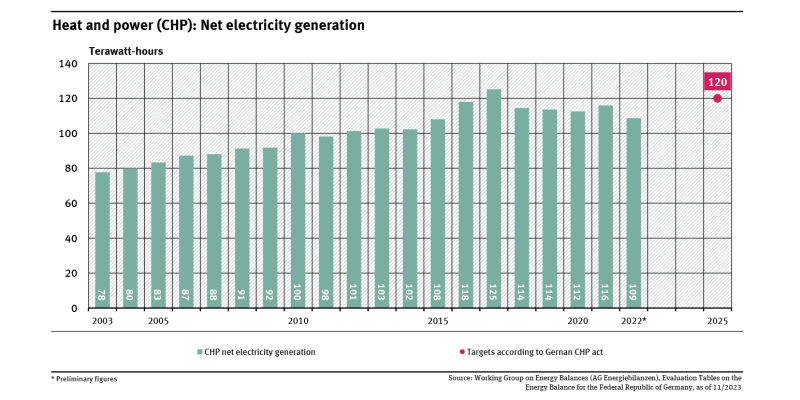Indicator: Combined heat and power (CHP)
 Click to enlarge
Click to enlargeSource: Working Group on Energy Balances Figure as PDF
 Umweltbundesamt
Umweltbundesamt
 Click to enlarge
Click to enlarge
- The volume of electricity generated by combined heat and power (CHP) has been increasing almost steadily until 2017.
- The decline in CHP electricity generation between 2017 and 2018 is due to a change in energy statistics: Since 2018, CHP plants have been recorded more accurately.
- The CHP Act stipulates that CHP should generate 120 terawatt hours (TWh) of electricity in 2025.
- The target of 110 TWh for CHP electricity generation was achieved in 2020.
Electricity generation usually also produces heat, which normally remains unused in conventional power plants. Combined heat and power makes use of this heat. CHP systems thus have a far higher fuel utilisation factor when operating as CHP. They use a significantly higher share of the energy than conventional systems. Compared with installations that generate electricity and heat separately, savings of up to 20 % primary energy are possible.
With decreasing energy demand, pressures on the environment associated with energy provision and transformation will also decrease. For instance, greenhouse gas emissions can be reduced by increasing the share of CHP. Demand for fuel will also decrease. The use of CHP can thus contribute to an economy that is light on resources.
Electricity generation by combined heat and power plants has seen an upward trend. The electricity generated rose from 78 TWh to 109 TWh in 2022. This increase was mainly due to the development and use of biomass for energy generation as well as the capacity expansion of natural-gas CHP. The decrease from 2017 to 2018 is mainly due to an improved energy-statistical accounting of CHP plants from 2018 onwards (for further information see Gores, Klumpp 2018, in German only). The moderate decline from 2018 to 2020 by around 1.8 percent to 112 TWh reflects the reduced demand for electricity during this period. It is mainly based on the decommissioning of CHP plants based on hard coal and lignite. During the same period, total net electricity generation fell by 9.8 percent.
With the revision of the Act on Combined Heat and Power generation (KWKG, in German only) in 2016 future targets of annual energy generation by CHP systems were stipulated. In 2020 the target is 110 TWh, in 2025 120 TWh shall be generated by CHP systems per year. The regulations of the new act are meant to improve the conditions for CHP. Overall, the legislation has a positive impact. CHP electricity generation in 2020 was 7 TWh above the target for that year.
The indicator is based on data for public and industrial power plants by the Federal Statistical Office (‘Monatsbericht über die Elektrizitätsversorgung’ and ‘Fachserie 4, Reihe 6.4’, in German only). However, these surveys do not cover all plants. As the data collection by the Federal Statistical Office does not cover all power plants new models were developed which consider electricity generation by additional power plants. The methodology and models are described in detail by Gores et al. (2014) and Baten et al. (2014) (in German only).
More detailed information: 'Kraft-Wärme-Kopplung (KWK)' (in German only) and 'Kraft-Wärme-Kopplung (KWK) im Energiesystem‘ (in German only).